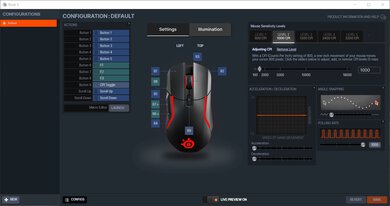The SteelSeries Rival 5 is a versatile wired gaming mouse. It's somewhat lightweight, feels sturdy, and has an ergonomic right-handed shape ideal for all grip types, but it isn't well-suited for small or medium-sized hands. It has five side buttons on the left, including a toggle switch with up/down inputs which acts as two buttons, a silver sniper button towards the front, and a pair of conventional side buttons. It also has a very low click latency, a wide CPI range, and a very low lift-off distance. Unfortunately, the CPI is only adjustable by increments of 100, and the onboard storage only has space for one profile and only saves specific settings.
Our Verdict
The SteelSeries Rival 5 is decent for office or multimedia work, though it isn't for this use. It feels sturdy and has a good number of buttons, all of which are programmable using the companion software compatible with Windows and macOS. It also has a comfortable right-handed shape that's well-suited for all grip types but isn't suitable for smaller hands. Unfortunately, there are no wireless connection options, and the scroll wheel lacks L/R tilt buttons and doesn't unlock for free scrolling.
-
Feels well-built.
-
Good number of buttons, and all buttons are programmable.
-
Wired-only.
-
Scroll wheel lacks L/R tilt buttons and doesn't unlock for free scrolling.
The SteelSeries Rival 5 is a great FPS gaming mouse. It feels well-built, is somewhat lightweight, and has an ergonomic right-handed shape that's well-suited for all grip types, but it isn't well-suited for small or medium-sized hands. It also has low click latency, a wide CPI range, and a very low lift-off distance. Unfortunately, you can only adjust the CPI by increments of 100. There's also only onboard storage for one profile, and you can only save specific settings.
-
Feels well-built.
-
Somewhat lightweight.
-
Good click latency.
-
Fairly stiff cable.
-
Only one onboard profile; not all settings are saved.
The SteelSeries Rival 5 is great for MMO gaming, though it doesn't have as many buttons as a dedicated MMO mouse. That said, you can program all the buttons it does have using the companion software. It feels well-built and has a comfortable shape suitable for larger hands using all grip types. It also has a low click latency, a wide CPI range, and a very low lift-off distance. Unfortunately, you can't set the CPI very precisely as it's only adjustable by steps of 100.
-
Feels well-built.
-
Good click latency.
-
Good number of buttons, and all buttons are programmable.
-
Not quite as many buttons as a dedicated MMO mouse.
-
Only one onboard profile; not all settings are saved.
The SteelSeries Rival 5 is inadequate for travel use as it's quite bulky and likely won't fit in most laptop cases. It's also a wired-only mouse, which makes it cumbersome in smaller spaces like planes, trains, or buses. Also, it only has one onboard storage profile, and you can only save specific settings.
-
Feels well-built.
-
Wired-only.
-
Bulky; may not fit into most laptop cases.
-
Only one onboard profile; not all settings are saved onboard.
- 6.3 Office/Multimedia
- 8.2 Video Games (FPS)
- 8.2 Video Games (MMO)
- 5.5 Travel
Changelog
- Updated Feb 22, 2023: We've converted this review to Test Bench 1.3. This update adds a new Sensor Latency test and makes minor changes to several of our existing tests, resulting in test result changes in several sections. For more information, you can check out our full changelog here.
- Updated Sep 28, 2022: We've converted this review to Test Bench 1.2. This update simplifies our Weight test and expands on our CPI test from Test Bench 1.1, resulting in changes to test results in both sections. For more details, you can see our complete changelog here.
- Updated Sep 21, 2022: We've converted this review to Test Bench 1.1. This update revamps our Click Latency test and results in changes to test results. For more details, you can see our full changelog here.
- Updated Jun 28, 2022: We noted minor errors in our measurements for the 'Grip Width' and 'Volume' tests for this mouse following the testing of the Aerox 5 Wireless, which shares the same shape. These measurements have been retested and corrected.
- Updated May 06, 2022: Following the testing of the similarly sized and shaped SteelSeries Aerox 5 Wireless, the suitability of this mouse for medium-sized hands using a claw grip has been reevaluated. The Claw Grip: Hand Size Recommendation test result for Medium Hands has been changed from Yes to No.
Check Price
Differences Between Sizes And Variants
The SteelSeries Rival 5 we tested is black in color, and there are no other variants. You can see the label for our unit here.
Compared To Other Mice
The SteelSeries Rival 5 is a continuation of the SteelSeries Rival lineup and follows in the footsteps of the SteelSeries Rival 600. It has an improved sensor, a better cable, and an expanded set of buttons on the left side. It's also much lighter, which addresses one of the major criticisms of the Rival 600 regarding its weight. It may be a great mid-range choice if you play games in different genres and need a mouse with extra side buttons but don't need the 12-button side panel of some dedicated MMO mouse. It's also a much lighter option than similar mice like the Razer Basilisk V2 or the Logitech G502 HERO.
Also check out our picks for the best gaming mouse, the best wired mouse, or the best SteelSeries mouse.
The Logitech G502 HERO and the SteelSeries Rival 5 are both very good, versatile gaming mice. The Logitech has a thumb rest, a scroll wheel that can unlock for free scrolling and that has L/R tilt buttons, and G-Shift programmability. Performance-wise, it also has a higher maximum CPI, a more precisely adjustable CPI, and a much better click latency. Comparatively, the SteelSeries has a better cable and more side buttons, including a toggle switch with up/down inputs. Both mice are ideal for all grip types, but neither is suitable for smaller hands.
The SteelSeries Rival 5 and the SteelSeries Aerox 5 are very similar, wired, gaming mice, but the Aerox 5 performs slightly better. The outer shell of the Aerox 5 has diamond-shaped cutouts to reduce the weight, and its latency is better. Also, it has higher quality feet. On the other hand, the Rival 5 feels better built, and its cable is better quality and more flexible.
The SteelSeries Rival 600 is a precursor to the SteelSeries Rival 5. The Rival 5 is significantly lighter, has an upgraded cable, better mouse feet, and a toggle switch with up/down inputs in the side button cluster. It also has a somewhat lower click latency and a new sensor with a higher maximum CPI. On the other hand, the Rival 600 includes a set of eight 4-gram weights if you prefer a heavier mouse or want to change the center of gravity. Both mice are ideal for all grip types but only for larger hands.
The SteelSeries Aerox 5 Wireless and the SteelSeries Rival 5 are multi-genre gaming mice that share the same right-handed shape. The Aerox 5 Wireless connects wirelessly with a USB receiver or via Bluetooth and has a body with honeycomb cutouts, making it lighter. It also has better-quality feet and somewhat lower click latency. On the other hand, the Rival 5 is a wired-only model. It has a solid plastic body and feels sturdier overall.
The Razer Viper Mini is better for FPS gaming, while the SteelSeries Rival 5 is more versatile. The Razer is much lighter, has a significantly lower click latency, and is suitable for smaller hands using a palm or claw grip and all hand sizes using a fingertip grip. The SteelSeries has better sensor performance, with a wider CPI range and a lower lift-off distance. It also has more side buttons, which you may prefer if you play various game genres. Its right-handed shape is ideal for all grip types but only for larger hands.
The Razer DeathAdder V2 is a comparable gaming mouse to the SteelSeries Rival 5. The Razer is lighter, has a higher maximum CPI, a more precisely adjustable CPI, and much better click latency. Comparatively, the SteelSeries feels sturdier, has a more flexible cable and three additional side buttons. It also has companion software compatible with Windows and macOS. Both mice are well-suited for all grip types and are best-suited primarily for larger hands.
The SteelSeries Rival 310 is a predecessor of the SteelSeries Rival 5. The Rival 5 is a better gaming mouse overall as it's lighter, feels sturdier, and has more side buttons, including a toggle switch up/down inputs. It also has an updated sensor with a higher maximum CPI and a lower lift-off distance. It's ideal for all grip types but isn't suitable for smaller hands. On the other hand, the Rival 310 is better suited for small hands using a palm grip but is only recommended for a fingertip grip for extra-large hands.
The SteelSeries Rival 5 and the SteelSeries Prime+ are wired gaming mice with comparable performance. The Prime+ is lighter and has a more precisely adjustable CPI. It also has an OLED screen under the mouse that you can use to customize settings without the companion software. Comparatively, the Rival 5 has three additional side buttons and a significantly lower click latency. Both mice are well-suited for all grip types, but those with larger hands may favor the Rival 5, while the Prime+ is more accommodating for smaller hands.
The ASUS ROG Keris is an excellent ultra-lightweight FPS gaming mouse, while the SteelSeries Rival 5 is a very good gaming mouse for a variety of uses. The ASUS is lighter, has less sensor variation, and lower click latency. On the other hand, the SteelSeries has a wider CPI range, a lower lift-off distance, and three additional side buttons. It also has customization software compatible with both Windows and macOS, while the ASUS only has software compatible with Windows. Both mice are well-suited for all grip types, but the SteelSeries is best suited for larger hands, while the ASUS is generally better-suited for smaller hands.
Test Results
The SteelSeries Rival 5 has an ergonomic right-handed shape and a solid matte plastic body. It has five side buttons on the left and a rubberized scroll wheel. It also has RGB lighting zones in the scroll wheel, the logo on the palm area, and two strips running along both sides of the body.
There's a similar version of this mouse that's designed to be more lightweight called the SteelSeries Aerox 5.
The SteelSeries Rival 5 has good button placement and a comfortable right-handed shape well-suited for all grip types. However, the mouse is fairly large, and smaller hands may have difficulty reaching the silver side button towards the front.
The cable feels high quality, and it glides smoothly on desks, though it retains some kinks from packaging.
You can program all of the buttons on the SteelSeries Rival 5, including the scroll wheel up/down inputs. The longer button above the two more conventional buttons on the left side is a toggle switch that counts as two buttons as it has up/down inputs that you can program independently.
The SteelSeries Rival 5 has good click latency. It should provide a responsive experience for most gamers. However, if you play faster-paced games or play more competitively, you may prefer a lower click latency.
The SteelSeries Rival 5 has a wide CPI range and a very low lift-off distance. You can set the polling rate to 125Hz, 250Hz, 500Hz, or 1000Hz. If you'd prefer a gaming mouse with a much more precisely adjustable CPI, check out the Corsair M65 PRO RGB.
The SteelSeries GG software is easy to use and has a clean, modern-looking interface. Unfortunately, you can only save one onboard profile that includes your CPI, polling rate, lighting brightness, and button mapping. Additional settings like lighting color, angle snapping, and acceleration require the software to be installed.
Note: The SteelSeries GG software is only available for Windows. However, the older SteelSeries Engine 3 software is compatible with macOS and provides the same functionality.
Comments
SteelSeries Rival 5: Main Discussion
Let us know why you want us to review the product here, or encourage others to vote for this product.

































